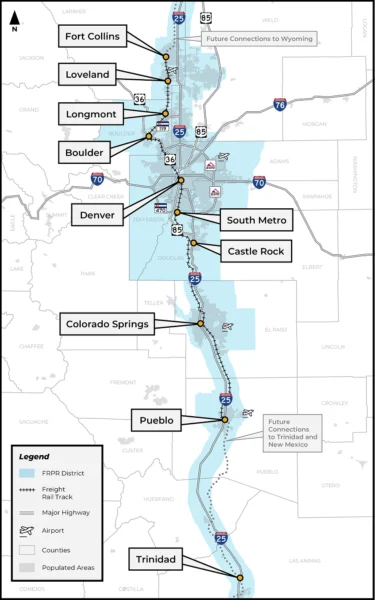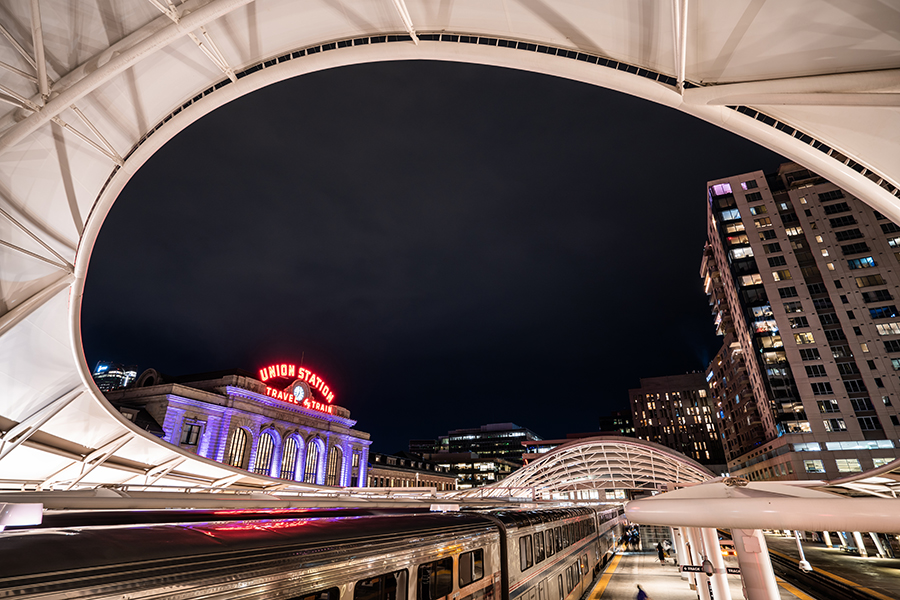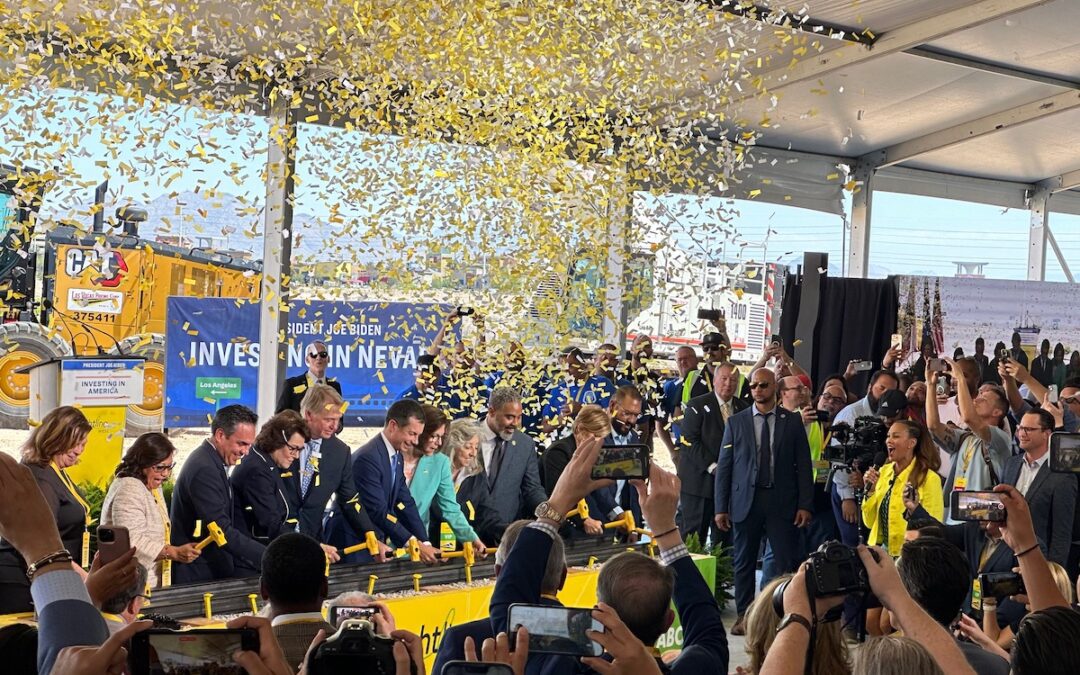The railroad Brightline today broke ground in Nevada on its new Brightline West project. Brightline will use trains traveling up to 200 miles per hour to cut the travel time between Las Vegas and Los Angeles in half. The company already operates successful trains...
Plans are well underway for a new regional rail route connecting communities in Colorado’s Front Range, one of the fastest-growing regions in the country.
The Front Range runs nearly 200 miles along the eastern foothills of the Rocky Mountains—south to north from Pueblo (CO) to Cheyenne (WY). It includes Denver, Boulder, Colorado Springs, Fort Collins, and other communities that are vital to Colorado’s booming tourist industry and overall economy.
About 85 percent of the state’s population clusters in the Front Range. Denver, located in the heart of the corridor, is one of the fastest growing cites in the US, both economically and population-wise. By 2050, the metro area is expected to grow to 4.4 million people (from 3.4 million in 2020).
Amtrak’s California Zephyr and Southwest Chief routes provide Colorado’s only year-round passenger-rail service. The state legislature created Front Range Passenger Rail District in 2021 as a special taxing entity and gave it the authority to ask residents, via a ballot measure, to approve a new tax to finance the construction and operation of passenger-train service in the Front Range. Advocates are working for the referendum to appear on the ballot in this fall’s election. A decision is expected by the end of April.
Meanwhile, plans for the corridor are moving forward. Along with 68 other projects, the FRPR District was accepted into the Federal Railroad Administration’s Corridor ID program in late 2023. The award includes $500,000 for planning. FRPR was one of just two corridors accepted into step 2 of the program, which means it’s in the advanced planning stages and will have an advantage in securing future federal grants.
Details and project timeline
 FRPR’s Service Development Plan—an analysis of potential routes, station locations, and costs, among many other things—will be completed by late 2025. Then the District will begin creating/evaluating financial strategies and moving through the environmental review process.
FRPR’s Service Development Plan—an analysis of potential routes, station locations, and costs, among many other things—will be completed by late 2025. Then the District will begin creating/evaluating financial strategies and moving through the environmental review process.
The service is expected to run from Pueblo to Fort Collins initially. Preliminary plans call for six to 14 daily round trips daily at speeds up to 79 mph. Amtrak is a potential service provider, but the District is also considering other options.
Service is expected to launch in the mid-2030s. If successful, it will likely be extended south to Santa Fe and north to Cheyenne. (Wyoming is one of three states not currently served by mainline passenger trains.)
Why it matters
Front Range Passenger Rail is a great model of building support for passenger trains among civic leaders, state policymakers, and the grassroots base—and creating strong relationships with relevant agencies at the state and federal levels.
In fall 2023, for example, the state’s governor, Jared Polis, took a test run of a prototype, hydrogen-powered train—with two train cars full of elected local and state officials on board—to build support for FRPR. Gov. Polis told a reporter on the trip that it was “time to just get it done.”
After the Corridor ID awards were announced later that year, the FRA’s administrator, Amit Bose, met with Polis to discuss FRPR. The meeting was also attended by legislators, local leaders, and advocacy groups.
“What the governor has laid out and the commitment that he’s demonstrated to passenger rail are definitely a model for the country,” Bose said. “We really want growing states like Colorado to embed passenger rail into the transportation system now, rather than after that growth happens.”
Strengths
FRPR has considerable strengths, including:
- Polls show strong public support for the project. One survey of residents found that 85% of respondents wanted to have the option of a passenger-rail line, for example, and 61% supported a tax increase to fund it.
- Denver’s railroad station—located in the heart of the city—is among the most impressive in the nation. The current Denver Union Station was originally built in 1914. It reopened in 2014 after a $54 million project to refurbish it as a multimodal transportation hub and thriving cultural, dining, and shopping destination.
- FRPR can potentially use an earlier initiative to build a commuter rail line from Denver to Longmont—called FasTracks—to accelerate momentum for FRPR. Initiated in 2004, FasTracks has stalled out because of revenue shortfalls. But the $190 million in sales tax already collected for it is still available. By partnering with FasTracks on design and funding requests, FRPR can potentially tap those funds while helping revive the project.
- Colorado has an ambitious plan to reduce greenhouse gas emissions by 100% (versus 2020 levels) by 2050. FRPR will give people the option of taking reliable, low-emissions trains instead of driving, so it’s a key tool for achieving that goal.
Challenges
- Polling results are favorable so far, but actually winning public support for a new tax—via the referendum—will be key to creating a steady, sustainable funding stream.
- Because FRPR is planning shared-use service rather than a high-speed line using dedicated tracks, it must coordinate with two freight railroads that very different views about passenger trains. BSNF owns the tracks north of Denver, while UP owns the tracks to the south. This split creates challenges in planning and operating the service as a single route.
- Although the FasTracks initiative (noted above) is a great opportunity to create efficiencies and synergies, blending a passenger-rail with a commuter-rail project also poses real challenges. The two systems often vary significantly in terms of speed, rolling stock, tracks, platforms, etc.
- Denver Union Station doesn’t have the capacity for through-running, which is unfortunate since Denver is roughly the midpoint of the Front Range line. Proposed workarounds will be part of the Service Development Plan.
Watch the video below with Front Range Passenger Rail District (FRPRD) General Manager Andy Karsian and Chairman Jim Souby as they share the vision and achievements to realize an additional travel option along Colorado’s Front Range through passenger rail.

Take Action
The country needs an Interstate Railway Program, like the Interstate Highway Program, to take full advantage of the community, economic, and environmental benefits of trains.
Please join with us in asking Congress to create a national railway program to re-connect America with fast, frequent, and affordable trains.
The Latest from HSRA
Our Latest Blog Posts
Check out the latest news, updates, and high speed rail insights from our blog!



